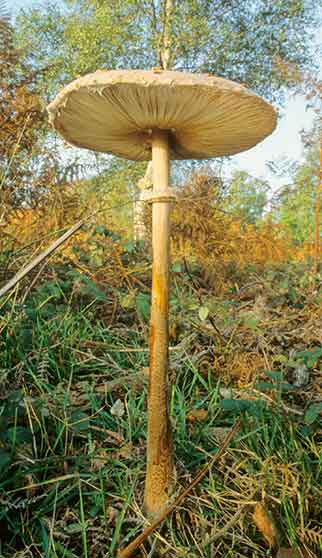Parasol Mushroom (Macrolepiota procera)

Parasol Mushroom
One of our most majestic fungi, Parasol Mushrooms grow tall and strong in a range of habitats, but particularly like open, grassy woodlands and pastures. Woodland edges are a favourite haunt, too, where the trees give way to grassland.
Parasol Mushroom caps - pale buff or grey-brown in colour, sprinkled with darker, shaggy scales and with a brown patch at the often raised centre - are initially egg-shaped but quickly expand and flatten. (The Italian name means drumstick, a reference to the long stem and initial cap shape, whilst the English common name recalls the shape of the light umbrella of the same name).
Examples with caps that measure 25 centimetres across have been recorded, whereas the stem - white with a grey-brown covering - can reach a height of around 30 centimetres. A quite prominent, loose fitting, fleecy ring is present on the stem - clearly visible in the illustration here. Gills are creamy-white in colour, prominent and well-spaced.
A late summer and autumn fungus, Parasol Mushrooms not only look good but are excellent to eat.
Confusion with the closely related Shaggy Parasol (Macrolepiota rhacodes), which also occurs in the New Forest, must, however, be avoided as the Shaggy Parasol has been know to cause gastric upsets - the Shaggy Parasol is typically shorter stemmed, has considerably more prominent, woolly scales, and, unlike the Parasol Mushroom, when cut or bruised shows a degree of red colouration.
Warning: refer to a good, comprehensive fungus field guide to confirm identification, and only eat those species known without any doubt whatsoever to be edible - people have died after eating certain poisonous specimens.
References:
Mushrooms and other Fungi of Great Britain and Europe - Roger Phillips
The Mushrooms and Toadstools of Britain and North-western Europe - Marcel Bon
Fungi of Britain and Europe - Stefan Buczacki and John Wilkinson
The MacDonald Encyclopedia of Mushrooms and Toadstools - Giovanni Pacioni
Fungi of the New Forest: A Mycota - Edited by Gordon Dickson and Ann Leonard
A Passion for Mushrooms - Antonio Carluccio
More links
Other related links
Search this site

Sadly, 58 animals were killed - 35 ponies, 13 cows, 8 donkeys and 2 sheep, whilst a further 32 were injured - 3 pigs, 9 donkeys, 11 cows and 9 ponies.
(Forty-three accidents occurred in daylight, 15 at twilight and 101 in the dark. Twenty-seven accidents were not reported by the driver involved).
Here's just one horrific example - Three donkeys killed in collision with van at notorious New Forest blackspot (Advertiser and Times)

